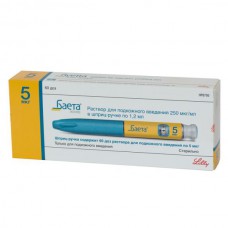Expiration date: 03/2026
The composition and form of issue:
Solution for subcutaneous injection, 1 ml contains:
exenatide 250 mcg
excipients: sodium acetate trihydrate, acetic acid ice, mannitol, metacresol, water d/and
in syringe pens with cartridges of 1.2 or 2.4 ml in a cardboard pack of 1 syringe-pen.
Description pharmaceutical form:
The solution for the p/to the introduction colorless, transparent.
Feature:
Hypoglycemic drug.
Pharmacokinetics:
Suction. After p/to the introduction of exenatide at a dose of 10 mcg in patients with diabetes mellitus type 2 exenatide is rapidly absorbed through the 2.1 CH reaches Cmax, which is equal to 211 PG/ml. AUCo-inf is 1036 PG×h/ml When exposed to exenatide AUC increases proportionately with dose from 5 to 10 mcg, there has not been a proportional increase in C Max. The same effect was observed when s/to the introduction of exenatide in the abdomen, thigh or forearm.
Distribution. The apparent volume of distribution (Vd) exenatide after p/to the introduction at 28.3 L.
Metabolism and excretion. Exenatide is excreted primarily through glomerular filtration with subsequent proteolytic breakdown. Clearance exenatide 9.1 l/h, the Final T1/2 is 2.4 h. These pharmacokinetic characteristics of exenatide not dose-dependent. The measured concentrations are determined exenatide for approximately 10 h post-dose.
Pharmacokinetics in special clinical cases. In patients with mild or moderately expressed violation of the kidney (Cl creatinine clearance 30-80 ml/min) clearance exenatide not significantly different from clearance in patients with normal renal function therefore, a correction dose is not required. However, in patients with end-stage renal failure, undergoing dialysis, the average clearance was reduced to 0.9 l/h (as compared with 9.1 l/h in healthy subjects).
Because exenatide is mainly excreted by the kidneys, it is considered that the liver does not change the concentration of exenatide in the blood.
Age has no effect on the pharmacokinetic parameters of exenatide. Therefore, elderly patients do not require a correction dose.
Exenatide the pharmacokinetics in children has not been studied.
Between men and women is clinically important differences in the pharmacokinetics of exenatide not observed.
Pharmacokinetics exenatide among representatives of different races practically does not change. Dose adjustment based on ethnic origin is not required to hold.
Not observed a significant correlation between body mass index (BMI) and the pharmacokinetics of exenatide. Dose adjustment taking into account the BMI conduct is not required.
Description pharmacological action:
Exenatide (exendin-4) is a mimetic incretin and is a 39-amino acid aminopeptidase. Incretins, such as glukagonovy peptide-1 (GLP-1), glucosidation enhance insulin secretion, improve the function of beta cells, suppresses inappropriately elevated glucagon secretion, and slows emptying of the stomach after getting into the bloodstream from the intestines. Exenatide is a potent mimetic incretin, which causes increased glucosidation insulin secretion and has other hypoglycemic effects inherent in the incretin, which helps to improve glycemic control in patients with diabetes mellitus type 2.
Amino acid sequence of exenatide partially corresponds to the sequence of human GLP-1, with the result that it binds and activates the receptor GLP-1 in humans, which leads to increased glukagonovykh synthesis and secretion of insulin from the beta cells of the pancreas with involvement of cyclic adenosine monophosphate (AMP) and/or other intracellular signaling pathways. Exenatide stimulates the release of insulin from beta-cells in the presence of elevated concentrations of glucose.
On chemical structure and pharmacological action of exenatide is different from insulin, sulfonylurea derivatives, derivatives of D-phenylalanine and meglitinides, biguanide, tiazolidindionov and inhibitors of alpha-glucosidase.
Exenatide improves glycemic control in patients with diabetes mellitus type 2 due to the mechanisms listed below.
Under hyperglycemic conditions glycosidation exenatide enhances insulin secretion from beta cells of the pancreas. The insulin secretion is stopped by decreasing concentrations of glucose in the blood and bringing it closer to normal, thereby reducing the potential risk of hypoglycemia.
Insulin secretion during the first 10 minutes, known as the "first phase insulin response" that is specific is absent in patients with diabetes mellitus type 2. In addition, the loss of first phase insulin response is an early dysfunction of beta cells in diabetes type 2. Introduction exenatide restores or significantly improves both the first and second phase insulin response in patients with diabetes mellitus type 2.
In patients with diabetes mellitus type 2 with hyperglycemia introduction exenatide suppresses excessive glucagon secretion. However, exenatide does not violate glucagonomas the normal response to hypoglycemia.
It has been shown that the introduction of exenatide leads to a decrease in appetite and decrease in food intake inhibits gastric motility leading to slowing of emptying it.
In patients with diabetes mellitus type 2 therapy exenatide in combination with Metformin and/or sulfonylureas leads to a decrease in glucose concentration in the fasting, postprandial blood glucose and increased glycosylated hemoglobin (HbA1c), thereby improving glycemic control in these patients.
Indications:
Diabetes mellitus type 2 as additional therapy to Metformin, sulfonylurea derivative, thiazolidinedione, the combination of Metformin and sulfonylurea derivative or Metformin and thiazolidinedione in case of failure to achieve adequate glycemic control.
Contraindications:
- hypersensitivity to the drug
- diabetes mellitus type 1 or the presence of diabetic ketoacidosis
- renal failure severe (Cl — creatinine <30 ml/min)
- the presence of severe diseases of the gastrointestinal tract with concomitant gastroparesis
- pregnancy
- lactation (breastfeeding)
- children up to age 18 years (safety and efficacy in children have not been established).
Application of pregnancy and breast-feeding:
The drug is contraindicated during pregnancy and breastfeeding.
Side effects:
Adverse reactions seen more often than isolated cases are listed in accordance with the following gradation: very often — &ge10%, often, &ge1% but <10%, sometimes — &ge0,1%, but <1%, rare &ge0.01% but <0,1%, very rare <0,01%.
From the digestive system: very often — nausea, vomiting, diarrhea, often — loss of appetite, dyspepsia, gastroesophageal reflux and sometimes abdominal pain, bloating, belching, constipation, a violation of taste sensations, flatulence.
CNS: frequently — dizziness, headache, rarely — drowsiness.
From the endocrine system: very often — hypoglycemia (in combination with sulfonylureas) often — the feeling of chills, weakness, hyperhidrosis.
Allergic reactions: rarely — rash, itching, angioedema very rare — anaphylactic reaction.
Other: often — skin reaction at the injection site rare — dehydration (associated with nausea, vomiting and/or diarrhea). The number of reported cases increasing the time of blood clotting (INR) with concomitant use of warfarin and exenatide, sometimes accompanied by bleeding.
Due to the fact that the frequency of hypoglycemia increases with a joint appointment of the drug Beta with sulfonylureas, there should be reduction in dose of sulfonylureas by increasing the risk of hypoglycemia. Most episodes of hypoglycemia in intensity was weak or moderate and were stopped oral intake of carbohydrates.
In General, side effects in intensity was weak or moderate and did not lead to the cancellation of the treatment. This files most often reported nausea mild or moderate intensity was dose dependent and decreased over time without interfering with everyday activity.
Drug interactions:
Beta the drug should be used with caution in patients receiving oral medications that require rapid absorption from the gastrointestinal tract, because Beta may cause a delay in gastric emptying. Patients should be advised to take oral drugs, whose action depends on their threshold concentrations (e.g. antibiotics) at least 1 h before the introduction of exenatide. If these drugs must be taken with food, you should take them during those meals when exenatide is not injected.
When concomitant administration of digoxin (at a dose of 0.25 mg 1 time/day) with a preparation Beta reduced the Cmax of digoxin by 17% and Tmax is increased by 2.5 h. However, the overall pharmacokinetic effect in the equilibrium state does not change.
Due to the introduction of the drug Beta AUC and Cmax of lovastatin was reduced by approximately 40 and 28% respectively and Tmax was increased by approximately 4 h. Joint appointment of the drug Beta with inhibitors of HMG-COA reductase was not accompanied by changes in the lipid composition of the blood (HDL-cholesterol, LDL-cholesterol, total cholesterol and triglycerides).
In patients with mild or moderate hypertension stabilized lisinopril (5-20 mg/day), the drug Beta did not change AUC and Cmax of lisinopril at equilibrium condition. The Tmax of lisinopril at steady state was increased by 2 h was Not observed changes in indicators daily average SBP and DBP.
Noted that administration of warfarin within 30 minutes after drug Beta Tmax was increased by approximately 2 h. Clinically significant changes in Cmax and AUC was observed.
The use of the drug Beta in combination with insulin, D-phenylalanine derivatives, meglitinides or inhibitors alpha-glucosidase has not been studied.
Method of application and dose:
Subcutaneously, in the thigh, abdomen or the forearm.
The initial dose is 5 µg, which is administered 2 times/day at any time within 60 minute period before morning and evening meal. Should not be administered after a meal. In the case of missing injections, the treatment continues without changes in the dose.
Within 1 month after the start of treatment the dose can be increased to 10 mcg 2 times/day.
When administered together with Metformin, thiazolidinedione or a combination of these drugs, the initial dose of Metformin and/or thiazolidinedione can not be changed. In the case of a combination drug Beta with sulfonylureas may require dose reduction of sulfonylurea derivative to reduce the risk of hypoglycemia.
Overdose:
Symptoms: severe nausea and vomiting, and rapid development of hypoglycemia (when taking doses 10 times above the maximum recommended).
Treatment: symptomatic therapy, including parenteral administration of glucose in case of severe hypoglycemia.
Special instructions:
Not recommended in/in or/m introduction of the drug.
Beta the drug should not be used if the solution detected particles or if the solution is cloudy, or has staining.
On the background of drug therapy Beta can develop antibodies to exenatide. However, this does not affect the frequency and types of registered side effects.
Patients should be informed that treatment with Beta can lead to loss of appetite and/or body weight and that for these effects there is no need to change the dosing regimen.
Patients before beginning of treatment Beta should see attached to the drug "Guide for the use of the pen".
The results of experimental studies
In preclinical studies on mice and rats revealed no carcinogenic effect exenatide. When administered to rats the dose 128 times higher than the dose in humans, noted a numerical increase in C-cell adenomas of the thyroid gland without any signs of malignancy that was associated with the increase in life expectancy of experimental animals receiving exenatide.
Expiration date:
After opening the store 30 days (at a temperature of 2 - 8 °C ).



